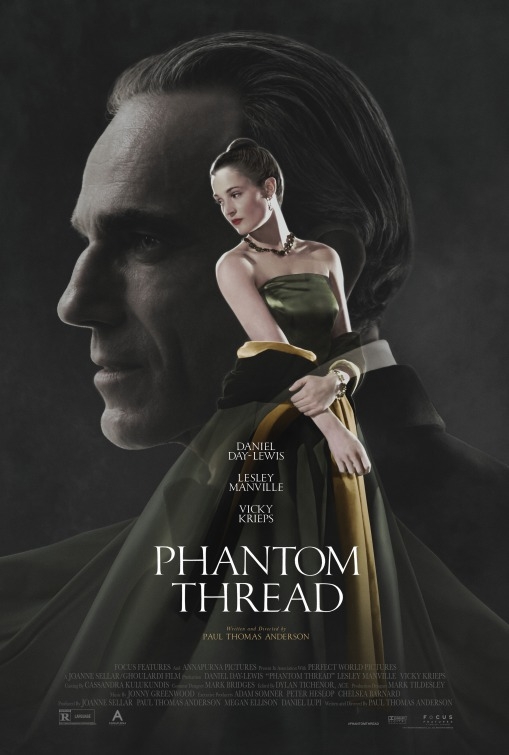Sound, Silence & Beauty in Phantom Thread

Bolstered by a phenomenal score, artistic direction and yet another terrific performance by Daniel Day-Lewis, Phantom Thread achieves a high level of cinematic achievement and leaves the audience in a dreamlike state that persists long after the credits role.
Paul Thomas Anderson teams up once again with acclaimed actor Daniel Day-Lewis and lauded composer Jonny Greenwood to tell us the story of Reynolds Woodcock (Daniel Day-Lewis), master couturier, and the journey through his relationship with a seemingly unremarkable waitress (Vicky Krieps).
The intimate and delicate tale the film weaves is a hard sell. Not everyone will be interested in the romance between a genius dressmaker and strong-willed woman. However, this piece set in the 1950’s has a surreal reality of life within its universe. It achieves cinematic excellence because everything that the screen encapsulates proves to be expertly crafted.
Paul Thomas Anderson’s use of silence and long takes prove highly effective. Most likely inspired from the works of Stanley Kubrick, the idea is reflected by the quote, “The less you say, the more your words will matter.” The more nothing is said, the more each word that is spoken signifies.
With greater use of long takes, the more the short takes will be meaningful. This philosophy allows for greater control over dramatic effect, which guides the emotion of the audience. Anderson is his own cinematographer, and he submerges the film in faded yet rich color, accentuated by creamy walls and soft firelight.
The three leads, Day-Lewis, Krieps and Manville, all pull off nomination worthy performances, achieving a chemistry certain to impress even the most skeptical of movie goers. Daniel Day-Lewis showcases a perfect balance of what many artistic geniuses are; a revolutionary in their craft and an unrelenting brat. The amazing subtle pronunciation of his mannerisms allow us to envision Reynolds Woodcock in his entirety. The faint locking of his jaw in his attempts to mask his deep frustration is worthy of an award in itself.
The dresses Woodcock and his team of women hand stitch together are remarkable in and of themselves. The attention to detail, use of certain colors and lush and vibrant designs are stunning. It does not take someone with a deep knowledge of fashion to recognize the talent of Mark Bridges, the costume designer at the helm of creating these works of art.
Arguably, the strongest aspect of the film is the score. Composed by Jonny Greenwood, Radiohead’s lead keyboard and guitarist, Greenwood creates an atmosphere with his music that is absolutely transcendent. The score is full of haunting strings, and melodic piano tones resulting in a deeply immersive and enriching experience.
Phantom Thread has Paul Thomas Anderson adding another masterful work of cinema to his collection. Put your preconceptions aside, and go into this film with an open mind – you might come out touched on the other side. If this is truly Daniel Day-Lewis’s final film, he chose the right note to bow out to.







